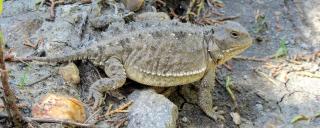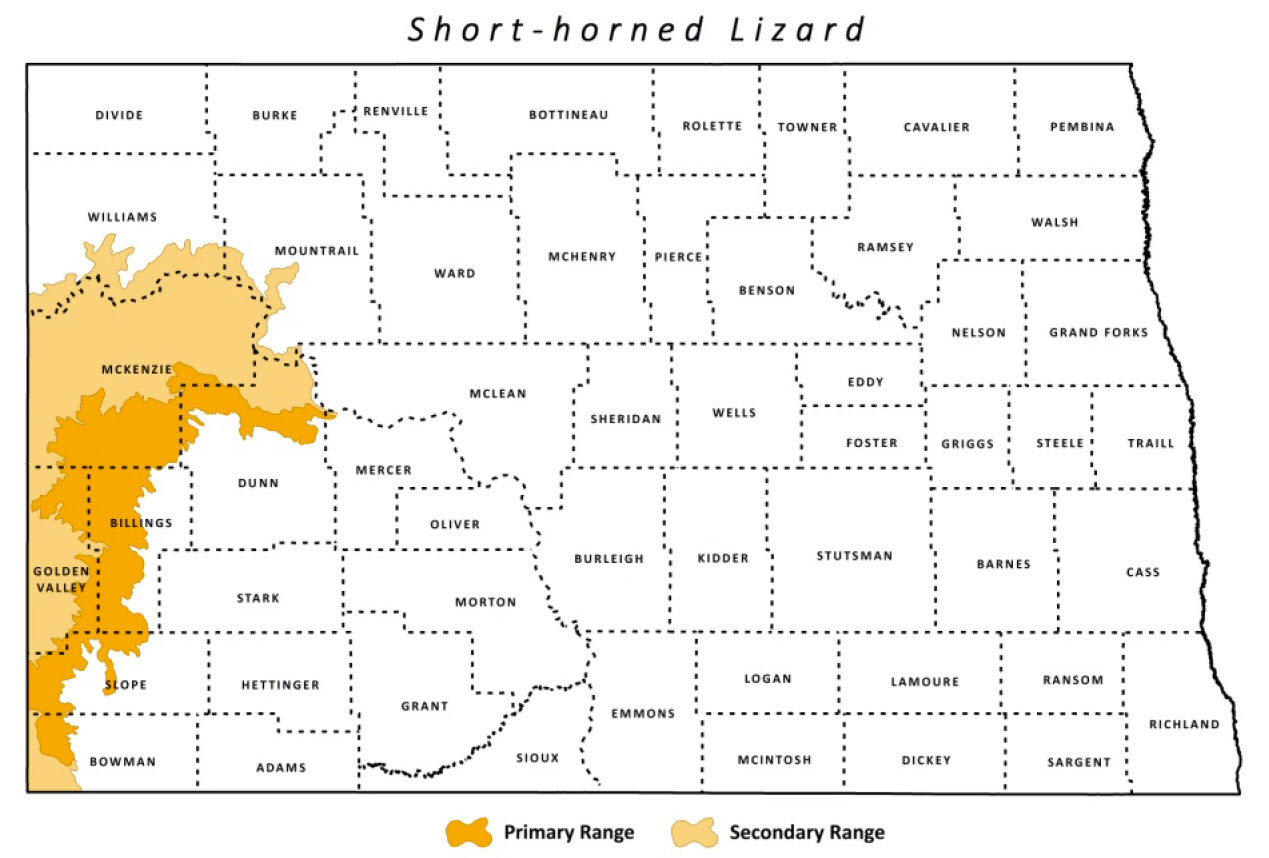
Short-horned Lizard
| Scientific Name | Phrynosoma hernandesi |
|---|---|
| General Description | L 2 ½ -4”. A flat, grayish body covered with numerous horns and spikes. Gives birth to 5-30 live young. |
| Status | Year-round resident. |
| Abundance | Uncommon, locally abundant. |
| Primary Habitat | Semi-arid, shortgrass prairie in rough terrain. |
| Federal Status | No federal status. |
| Reason for Designation | Listed as Imperiled in South Dakota and Saskatchewan and Vulnerable in Montana by NatureServe. Once listed as a federal candidate species, little is known of this species in North Dakota. |
Locations and Conditions of Key Habitat
Preferred Habitat
Arid landscapes, shortgrass prairie, and rough terrain are the primary habitats of the Short-horned Lizard. Open areas, shrubby, or open woody areas with sparse ground vegetation are also used. The lizards burrow into the ground in sandy soils and will also occupy abandoned rodent burrows. Feed on small insects, ants, and spiders.
Key Areas and Conditions for Short-horned Lizard in North Dakota
Most specimens have been encountered in the badlands and surrounding breaks.
Problems Which May Affect this Species
Habitat
Destruction and/or degradation of grassland and shrubland habitat.
Other Natural or Manmade Factors
It is unknown what effect pesticides, development, and other disturbance has on populations of Short-horned Lizards.
Research and Survey Efforts
Current Research or Surveys
- There is currently nothing specific to the species in North Dakota
Previous Research or Surveys
- University of North Dakota studied Climate Change and Land use Effects on Small Mammal Communities in a Northern Great Plans Landscape. This work included herptile surveys.
- Wheeler and Wheeler (1966) conducted a statewide survey of all amphibians and reptiles, as well as compiled existing records. The skinks were only found in the southeastern corner of the state.
- Hoberg and Gause (1992) recorded personal observations of prairie skinks in North Dakota.
- A compilation of all records in North Dakota by Jundt (2000) listed roughly 20 documentations of the Short-horned Lizard in the state.
Additional Research or Surveys Needed
Future efforts could include visual encounter surveys as the most productive method for determining presence.
Management Recommendations
- Prevent overgrowth by shrubs and trees to maintain openness in sand habitats.
- Restrict off-road vehicle use to preselected, less sensitive/lower quality areas.
Monitoring Plans
Currently no monitoring is taking place. Possible monitoring options could include school classes/programs including universities, the general public through the NDGFD incidental reporting system, or national monitoring initiatives such as PARC. Monitoring should be directed at a number herptile species.
2005-2015 Progress
The Short-horned Lizard maintains a level II Species of Conservation Priority. More information is needed to understand the status of this species in North Dakota. Work toward a monitoring plan is needed.

Note: A listing of works consulted when compiling the information on this page may be found in the 2015 State Wildlife Action Plan.
